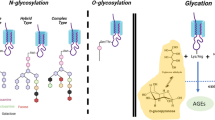Summary
The presence of an α-galactolipid was investigated with a peroxidase-labelled lectin fromGriffonia simplicifolia (GSA-I) with specific binding for terminal α-d-galactose residues. Normal kidney tissue was obtained from patients undergoing nephrectomy for renal neoplasms. For light microscopy, tissue was snap-frozen; 4 µm-thick sections were briefly fixed in paraformaldehyde and incubated with GSA (0.025 mg ml−1). The peroxidase activity was developed with 3-amino-9-ethylcarbazole. Adjacent sections were stained at the same time after lipid extraction with 3:1 (v/v) chloroform/methanol. For electron microscopy, 0.2–0.5 mm-thick paraformaldehyde-fixed blocks, with or without lipid extraction, were stained with peroxidase-labelled GSA. The label was developed with diaminobenzidine and osmium tetroxide. Some structures, such as tubular epithelia, stained both in lipid-extracted and non-extracted tissues, suggesting that glycoproteins were most likely involved. In addition, tissue stained immediately after fixation showed GSA reactivity on endothelial cell surfaces of intertubular capillaries and larger vessels. In lipid-extracted tissues, however, tubular epithelium was still positive for GSA but endothelial cells failed to stain. These findings suggest that a glycolipid, bearing a terminal α-galactose residue, is present on the endothelial cells in human kidney and possibly on tubular epithelia. Our data may explain the preferential storage of α-galactolipid in endothelial cells of patients with Fabry's disease and other biological phenomena such asEscherichia coli adhesion.
Similar content being viewed by others
References
CAPUTTO, R., MACCIONI, A. H. R. & CAPUTTO, B. L. (1977) Activation of deoxycholate solubilized adenosine triphosphatase by ganglioside and asialoganglioside preparations.Biochem. Biophys. Res. Commun. 74, 1046.
CLAUSEN, N., LEVERY, S. B., NUDELMAN, E. D., STROUD, M., SALYAN, M. E. & HAKOMORY, S. (1987) Isolation and characterization of novel glycolipids with blood group A-related structures: galactosyl-A and sialogalactosyl-AJ. Biol. Chem. 262, 14228–34.
DE MAN, P., CEDERGREN, B., ENERBACK, S., LARSON, A. C., LEFFLER, H., LUNDELL, A., NILSON, B. & SVANBORG, E. C. (1987) Receptor-specific agglutination tests for detection of bacteria that bind globoseries glycolipids.J. Clin. Microbiol. 25, 401–6.
FLEMING, S. & JONES, D. B. (1988) Antigenic heterogeneity of renal endothelium.J. Pathol. 154, 35.
HAKOMORY, S. (1981) Glycosphingolipids in cellular interaction, differentiation and oncogenesis.Ann. Rev. Biochem. 50, 733–7.
HENNIGAR, R. A., SCHULTE, B. A. & SPICER, S. S. (1985) Heterogeneous distribution of glycoconjugates in human kidney tubules.Anat. Rec. 211, 376–90.
LAITINEN, L. (1987)Griffonia simplicifolia lectins bind specifically to endothelial cells and some epithelial cells in mouse tissues.Histochem. J. 19, 225–34.
LINDBERG, F., LUND, B., JOHANSSON, L. & NORMARK, S. (1987) Localization of the receptor-binding protein adhesin at the tip of the bacterial pilus.Nature 328, 84–7.
MAKER, B. A. & SWEELEY, C. C. (1978) Glycosphingolipids: structure, biological source and nomenclature.Methods Enzymol. 50, 236–10.
MARKWELL, M. K., SVENNERHOLM, L. & PAULSON, J. C. (1981) Specific gangliosides function as host cell receptors for Sendai virus.Proc. Natl. Acad. Sci. USA 78, 5406–10.
O'HANLEY, P., LARK, D., NORMARK, S., FALKOW, S. & SCHOOLNIK, G. K. (1983) Mannose-sensitive and Gal—Gal bindingEscherichia coli pili from recombinant strains. Chemical, functional, and serological properites.J. Exp. Med. 158, 1713–19.
ROBERTS, D. D., NAGESWARA, R., MAGNANI, J. L., SPITALNIK, S. L., LIOTTA, L. A. & GINSBURG, V. (1985) Laminin binds specifically to sulphated glycolipids.Proc. Natl. Acad. Sci. USA 82, 1306–9.
SVENNERHOLM, L., FREDMAN, P., ELWING, H., HOLMGREN, J. & STRANNENGARD, O. (1980) Gangliosides as receptors for cholera toxin, tetanus toxin and Sendai virus. InCell Surface Glycolipids (edited by SWEELEY, C. C.) A.C.S. Symposium Series128, p. 373. Washington, DC.
Author information
Authors and Affiliations
Rights and permissions
About this article
Cite this article
Faraggiana, T., Crescenzi, A. & Marinozzi, V. Presence of an α-galactolipid on the cell surfaces of endothelial cells of human kidney. Histochem J 21, 235–240 (1989). https://doi.org/10.1007/BF01747526
Received:
Revised:
Issue Date:
DOI: https://doi.org/10.1007/BF01747526




